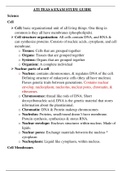ATI TEAS 6 EXAM STUDY GUIDE
Science
Cell
➢ Cell: basic organizational unit of all living things. One thing in
common is they all have membranes (phospholipids).
➢ Cell structure organization: All cells contain DNA, and RNA &
can synthesize proteins. Consists of nucleic acids, cytoplasm, and cell
membrane.
o Tissues: Cells that are grouped together
o Organs: Tissues that are grouped together
o Systems: Organs that are grouped together
o Organism: A complete individual
➢ Nuclear parts of a cell
o Nucleus: contains chromosomes, & regulates DNA of the cell.
Defining structure of eukaryotic cells (they all have nucleus).
Passes genetic traits between generations. Contains nuclear
envelop, nucleoplasm, nucleolus, nuclear pores, chromatin, &
ribosomes.
o Chromosomes: thread like rods of DNA. Short
deoxyribonucleic acid, DNA is the genetic material that stores
information about the plant/animal.
o Chromatin: DNA & Protein makeup chromosomes
o Nucleolus: Proteins, small/round doesn’t have membrane.
Protein synthesis, synthesizes & stores RNA.
o Nuclear envelope: Encloses structures within nucleus. Made of
lipids.
o Nuclear pores: Exchange materials between the nucleus *
cytoplasm
o Nucleoplasm: Liquid like cytoplasm, within nucleus.
Cell Membranes
,➢ Cell Membrane (Plasma membrane): Semipermeable membrane of
lipids and proteins. Made of phospholipid bilayer, hydrophilic ends
of the outer layer facing the external environment, the inner layer
facing inside the cell, hydrophobic ends facing each other.
o Hydrophilic: Water loving, can dissolve water
o Hydrophobic: Hates water, can’t dissolve water
➢ Selective Permeability
o Selective Permeability with regards to size, charge, and
solubility.
➢ Cell structure
o Ribosomes: synthesize proteins from amino acids.
o Golgi apparatus: synthesize materials like proteins that are
transported out of the cell. Near nucleus & consists of layers of
membranes.
o Vacuoles: Sacs used for storage, digestion, and waste removal.
One large in plant cells/ Animal cells are small or have
numerous.
o Vesicle: Has membrane, & can move materials within the cell.
o Cytoskeleton: Microtubules that shape and support the cell.
o Microtubules: Part of cytoskeleton & help support cell. Made
of protein.
o Cytosol: Liquid material within the cell. Mostly water & had
floating materials.
o Cytoplasm: Cytosol & organelles found within the plasma
membrane, not within nucleus!
o Cell membrane: Barrier that keeps materials out of cell.
Determines what’s allowed in and out.
o Rough Endoplasmic reticulum: Ribosomes on the surface,
produce & store proteins
o Smooth Endoplasmic reticulum: Helps store lipids & proteins.
, o Mitochondrion: Generate ATP, involved in cell growth &
death. Contain their own DNA aside from the one within the
nucleus.
▪ Functions: Produce energy, cell signaling, cellular
differentiation, cell cycle & growth regulation. Can also
have aerobic respiration.
➢ Animal Cell Structure
o Centrosome: Mitosis & the cell cycle occur here
o Centriole: Cellular division
o Lysosome: Digests proteins, lipids, and carbohydrates. Help
remove undigested substances.
o Cilia: Appendages that cause a cell to move & can move fluid
o Flagella: Tail like structures that help the cell move. A cell
usually only has one or a few flagella. Longer than cilia.
➢ Cell Cycle: Cell reproduces, growth cell, duplication of genetic
material, and cell division.
➢ Cell Differentiation: Helps determine the cell type for each cell,
process is controlled by genes of each cell (zygote). Following the
directions of the genes, a cell builds certain proteins and other
substances to set it apart as a specific type of cell.
➢ Mitosis: DNA replication & Production of new cells
▪ IPMAT=Cytokinesis
o Interphase: Cell prepares to divide by replicating genetic &
cytoplasmic material. (G1, S, G2)
o Prophase: Chromatic thickens & nuclear membrane disintegrates.
Centrioles move to opposite sides of the cells, and spindle fibers
form. Mitotic spindle, formed cytoskeleton parts, moves
chromosomes around the cell.
o Metaphase: Spindle moves to the center of the cell. Chromosomes
align in the center.




